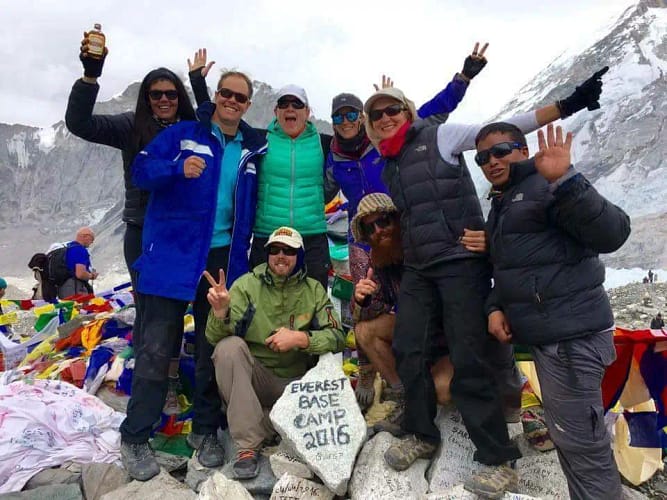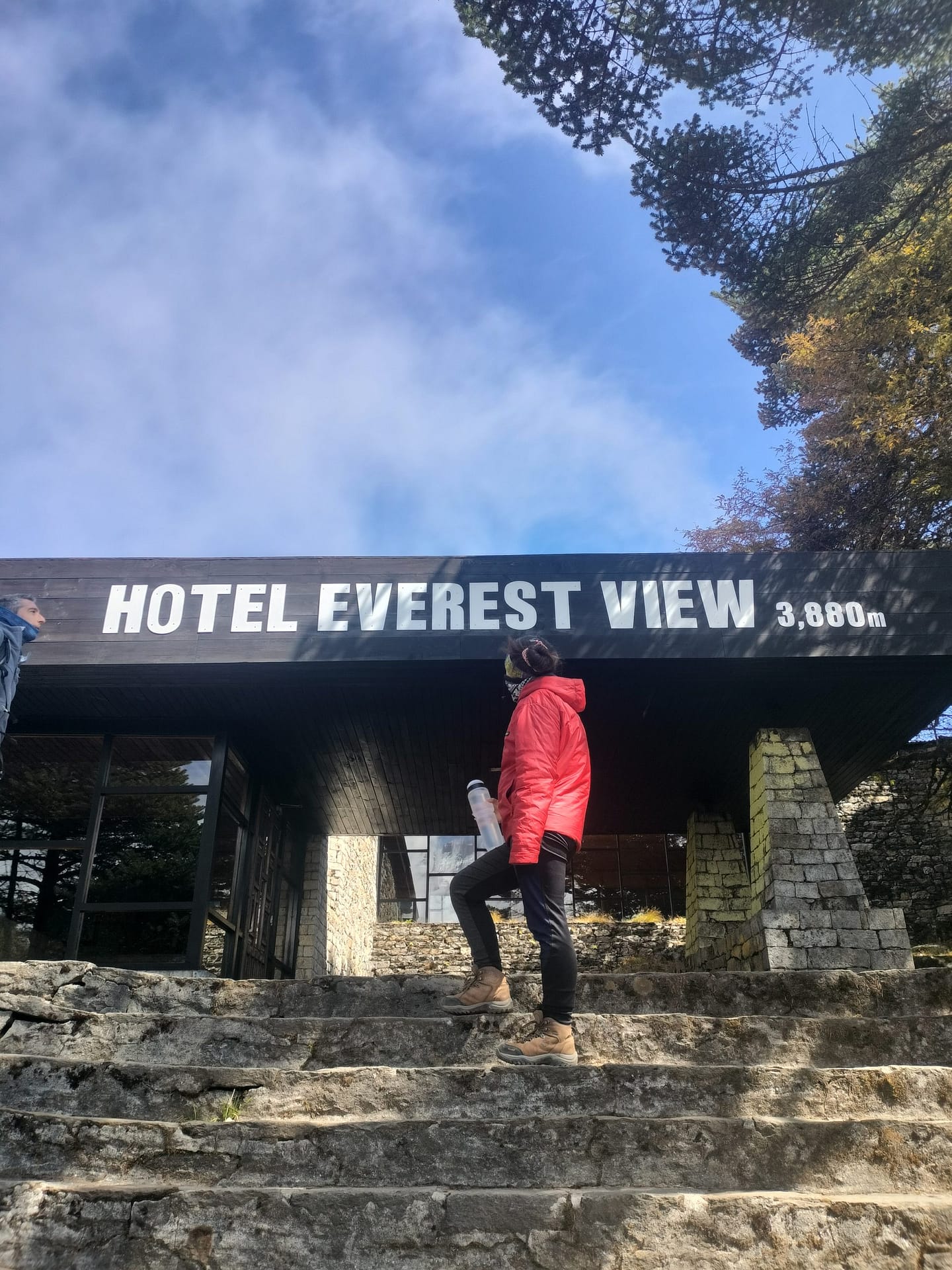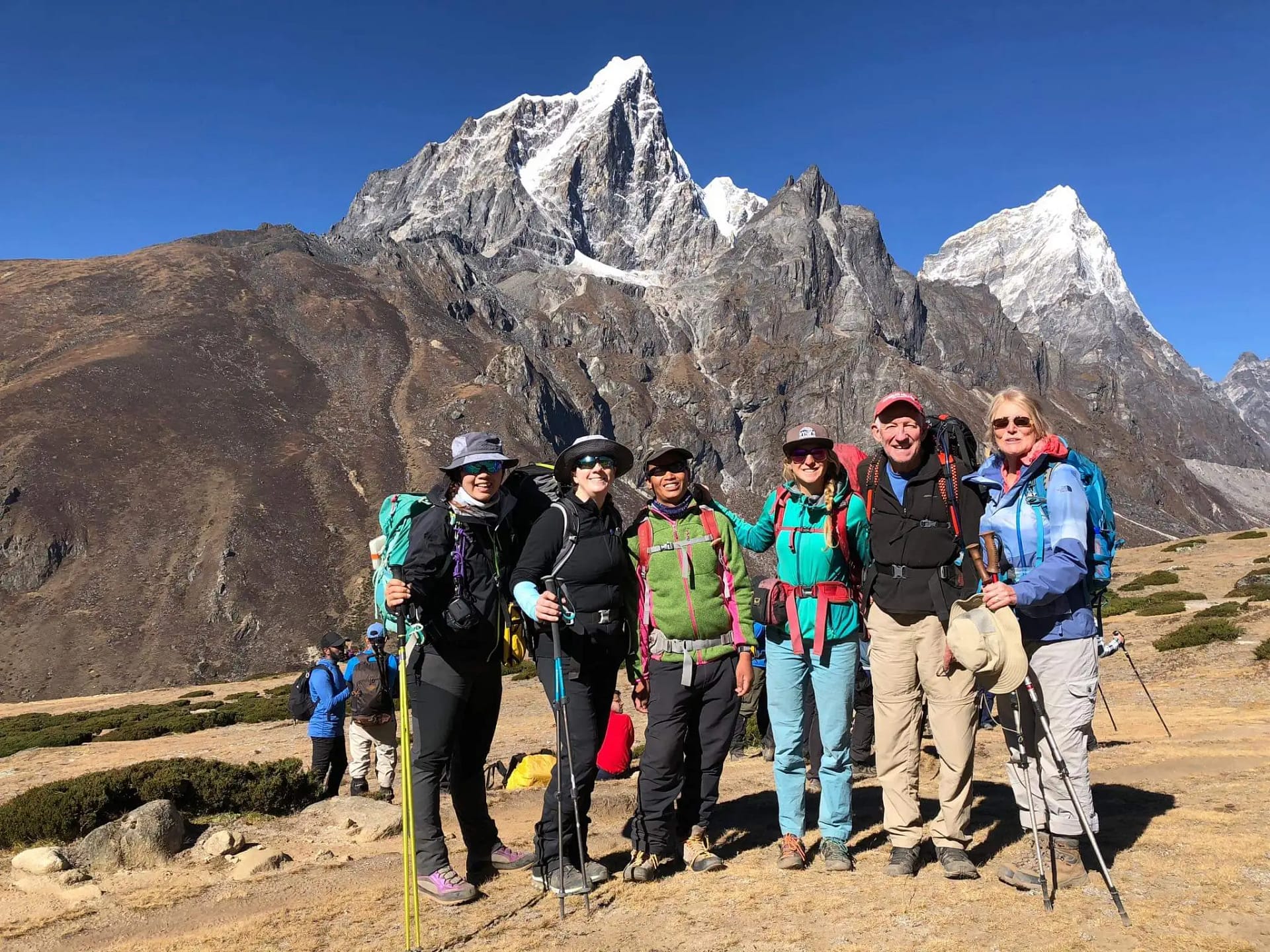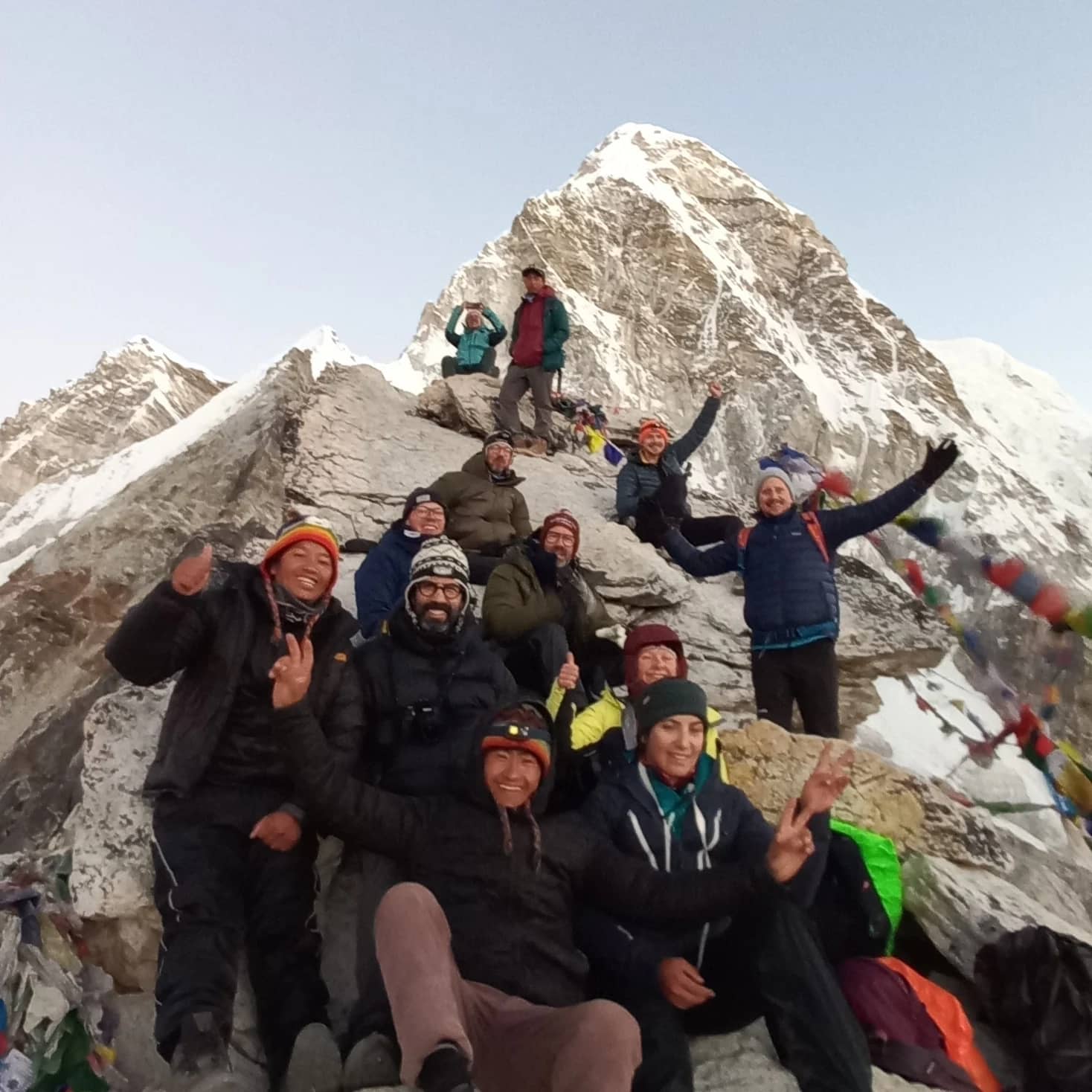Everest Base Camp Trek


everest-base-camp

Near Labuche

Everest Panaroma trek

Everest base camp
Highlights of the Everest Base Camp Trek
- Nearest live view of the World’s Highest Peak
- Namche Bazar; The capital of Brave Sherpa History
- Tengboche, Khumjung, Pangboche, and many other historical Monasteries
- World’s deepest Glacier, Khumbu Glacier
- Sagarmatha National Park; Inhabitant of the world’s rarest species
- Traditional Sherpa Practices
- Adventurous aerial view of the EBC mountain range.
- Amazing Sherpa Cultural Practices
- Mountain summit experience and many more.
Overview of Everest Base Camp Trek
Everest Base Camp Trek
Everyone dreams of touching the world’s highest Mountain, and few of them the lucky one can get this job done. among them You might be the next one of the luckiest ones! Everest Base Camp lies at a massive altitude of 5,364m that is in Everest region of Nepal. EBC trek is also one of the famous and highly preferred trekking destinations in Nepal, with tons of indescribable aspects of mountaineering and Nature.Everest Base Camp comprises all the masala required for true nature enthusiasts to experience the rawness of natural life and greenery. On the way while doing Everest Base Camp trek the big life-threatening hills will make you feel you are on the edge of your life. The beautiful and cold glacier river that is never ending and unique whitish snowy terrains with a variety of species on the way make this journey genuinely remarkable.
The journey to Everest Base Camp trek continues exploring the challenging routes with almost minus-degree temperatures in the winter months. Along the way you witness the base city of Everest Base Camp trek, i.e. Namche Bazaar which is also known as “the city of Sherpa’s” , at an altitude of 3440 m, is our stopping point where we have our food and accommodation.
Some people also like to do short trek to Everest region that is Everest Panaroma trek Apart from that we will also get a chance to visit an exceptionally well-preserved Sagarmatha National Park, that have 208 bird species and scarce animals like Himalayan Black Bear, Snow panda, Red panda, and other many more uncountable species are discovered which we can witness during Everest Base Camp Trek
Permits for Everest Base Camp Trek
The Government of Nepal imposes permit entrance fees to preserve the beauty surrounding Mt. Everest and other mountains in the Himalayan range.
All national parks in Nepal need a permit, and the Sagarmatha National Park is no different. When you compare the cost of the permits to the overall cost of your trip to Nepal and the Everest Region, the amount is relatively small. It is an investment in the future of this beautiful area with its snow, forests, ice, pastures, and culture.
Sir Edmund Hillary and Tenzing Norgay may have been the people to put the Khumbu on the map, but since then, countless mountaineers and trekkers have enjoyed the beauty of the likes of Mt. Everest, Ama Dablam, Goyko Lakes, and much more. Let’s ensure this area stays as it is for future trekkers and Nepali people.
For the Everest Base Camp (EBC) Trek, you need entrance permits as explained below:-
- Khumbu Pasang Lhamu Rural Municipality Entrance Permit (NPR 2000 Per Person)
- Sagarmatha National Park Entry Permit (NPR 3000 Per Person)
Important Notes for EBC Trek
- Flights to the Everest Region now depart from Ramechhap airport due to congestion at the Kathmandu airport. Ramechhap is several hours’ drive from Kathmandu, so we leave Kathmandu at 1 am to reach there for the early morning flights. There are no day or evening flights due to the high winds in the mountains in the afternoons.
- Flights can be delayed or canceled due to bad weather. We recommend you build in a 2 or 3-night contingency plan. That means do not book your international flight for Tuesday if your planned flight from Lukla is on Monday. Best to book it on Thursday or Friday.
- If you wish to take a helicopter flight from Kathmandu to Lukla, there will be an additional charge of around $250 to $300.
- There is no additional fee for the package rate for solo travellers. However, if you are travelling alone and wish for a single room, please add on the single supplement during checkout.
- Porters can only carry 20kg. So please pack lightly. We will provide you with a bag/duffle bag that is easy for porters to carry.
- Airlines have a weight limit of 15kg per person. Any excess can be paid at the airline counter at the airport. Note that this is only possible if the flight is not overweight already. Again, please pack lightly.
- Please provide us with a copy of your passport at the booking stage, as we require this for domestic flight booking.
- Meals on the trek are included in the price. This does not include hot or cold drinks, alcohol, or extra snacks. In Kathmandu, breakfast is included, but not lunch or dinner.
- There are extra expenses for hot showers ($3 to $5) and charging your battery ($1 to $3).
- You can buy a wifi card in Lukla or Namche Bazaar for $25. 10 or 20 GB of data are provided for use over 30 days in the Everest Region. We cannot guarantee the wifi quality – it will depend on the weather and location.
- Weather can change dramatically and quickly in the mountains, so please bear with us if there are delays. Please follow the advice of your guide if he needs to change the itinerary in any way due to the weather.
- Drones are not permitted unless you have a special permit to fly them in the Everest Region. This is because there are many unscheduled helicopter flights in the sky. It is tricky to obtain permission, so leave it home unless you need a drone.
- Remember your insurance!
- Most of all – enjoy your amazing adventure!
Itinerary of Everest Base Camp Trek
Day 1:- Welcome to Kathmandu:
Our team will welcome you at Tribhuwan International Airport on the very first day. You will check in the hotels and explore the Kathmandu valley with our guide staff. On the same day, you will get a chance to visit the historical and religious sites. As Kathmandu is called the City of Temples, you will find a temple after every three houses. The fantastic thing about the capital city is there are seven UNESCO World Heritage sites.
Day 2:- Shopping and preparation for the Trek:
On the second day in Nepal, You will explore the Nepali cultural sites and experience some Nepali foods. Later half, you will shop for the required clothes and materials and make yourself prepare for the Trek. You will also prepare all the documentation permits for the EBC trek on this day.
Day 3:- Fly to Lukla and trek to Phakding
The actual Trek begins from Lukla.The journey begins with an exciting Thirty-five minutes Flight from the capital city (Kathmandu) to Lukla airport. However, the actual Trek starts with Lukla hiking the mountains and terrains. Every year more than fourty-thousand people treks in the EBC region. The unpredictable weather of the Everest region is one of the most adventurous things during the tour. The actual feeling of genuine peace arises looking at the tall standing range of mountains.We will have our breakfast in lukla after that we will gradually descend to Phakding and on the way we will get a glimpse of Mt.Khumbila.

First Day of Hike:-
Destination:-Phakding
Just after landing on the land of heaven, we begin our Hike through the Khumbu region.We head towards our destination, following Chaurikharka village and DudhkoshiGhat. This Trek is not only natural but also culturally well-decorated. The most helpful person on the planet, ‘Sherpa,’ lives in significant numbers in such touch temperatures. Drinking fresh yogurt from yak keeps us charged all the time. The greenery forest and the adventurous suspension bridge will make you behave like a small child.
The Chaurikharka, Chheplung, Nachipang, and Koshigaun villages will make you realize one must find happiness in sorrows. The geographically challenging villager out there are culturally well-decorated and emotionally attached to every tourist who visits out there. Their hospitality makes every individual bow their head.
For a good view of beautiful blue pines growing by the river valleys, one must trek this region between March and May. We will reach our Day 1 Destination, Phakding, within 4 hours of a casual hike.
Day 4 : Phakding to Namche Bazaar
On the next day, i.e., Day 3 of our Hike, our minds will be excited. Just after the Breakfast, we head towards the city of Sherpas’ Namche Bazar’. Namche is where all the trekking-related shopping is done in case one forgets to shop in Kathmandu Valley. Namche Bazar is also called the Gate of Mt. Everest.
We pass through villages like TokTok, Benker, Jorsalle, and Monjo. Following the routes, we will get encircled by a vast range of hills and forests. The peaks are gigantic, with a height of more than 6000m. On the way, we will also explore Sagarmatha National Park, which comprises more than 40 giant ranges of mountains. Here, we get the permit for the further Trek.
After many climbing the mountains, we will finally reach Namche Bazar. This city’s advantage is that almost 98% of the houses here provide housing and lodging facilities. Nearly every stone is carved with the spiritual Mantras of Buddhists. You can also find many Monastries and Flags along with giant bells that resemble the Buddhist Peace.
The quick breath will realize you that you’ve reached a massive altitude. The Village Namche Bazar looks like a VFX-created scenery. The beauty it poses is just magical. The hills support each other to form a vast mountain range. The Himalayan glacier river’s high-pitched sound enters your eardrum and gives you inner peace.
On the way, you will notice a Hillary suspension Bridge with flags and Khata, which resembles the respect of the Nepali community towards Sir Edmund Hillary.
Day 5:- Acclimatization Day in Namche Bazaar
On reaching Namche Bazar, you sense the Hike as the milestone of your life. You will be taking some great panorama clicks to see the inexpressible beauty of Namche Bazar. The traditional Sherpa household pieces of equipment, their daily lifestyle, cultural practices, and the purity in their heart may surprise you. You will also discover the brave history of the Sherpa community in the field of mountaineering.
You will be exploring the beauty of Namche on this day, spending the night at local homestays. You will also visit Khumjung Monastery (one of the most visited cultural heritage sites) or Everest view hotel( Highest Placed Hotel in the world at 13000ft), and come back to Namche at the same day.

Day 6:- Namche Bazaar - Tengboche
Continuous 5 hours trek from Namche Bazaar to the Tengboche Monastery (3,860m).The majestic view alongside the glacier river disappears all your tiredness. The best part of the Trek is you will never feel tired of seeing the undescribable creation of Nature. Overnight stay at a guest house. Tengboche Monastery is one of the most famous monasteries of Nepal, probably because of the unrivalled backdrop of Mt. Ama Dablam, the walk from Namche Bazaar to Tynbouche (or Tengboche) is a pure delight every step of the way. The path is good, the views are incredible .
Day 7: Tengboche to Dingboche
Tengboche to Dingboche is a challenging section in the Everest Base Camp trek. You need to traverse diverse landscapes along the trail to arrive at Dingboche. Trekkers pass alongside the river below the valley on this beautiful trek section.
Moreover, the course of this trek also takes you through the village of Pangboche below the beautiful Mt. Ama Dablam.

However, there are steep uphills and a slight incline.
After breakfast at the teahouse early in Tengbuche we will observe the morning prayers at the Tengboche monastery. The spiritual environment of the region is quite enchanting, and you will cherish it thoroughly. After that, we will start our journey to Dingboche, passing through the various settlements of their area.
You will descend into numerous settlements before arriving at your destination. One of them is Deboche, where you will find many local settlements. You will cross this Deboche and then begin your journey uphill, where you will arrive at a place with many inscribed stones.
There you will cross a suspension bridge alongside the valley. The majestic views of Ama Dablam and other surrounding mountains are the prime attraction along the trail. You will arrive at Shomare after trekking for a few hours, where you will stop to have lunch. There you can get the best views of the snow-clad Himalayas from a viewpoint. You will leave Shomare and climb the trail uphill in the region.
You will continue along the valley trail and cross the river through a suspension bridge. After you arrive at Dingboche, you can rest at the teahouse.
Day 8: Accliazation day in Dingboche
Dingboche is also known as the last village of Everest Base camp.The acclimatization at Dingboche includes various small hiking peaks.You can also explore around if you like. The trekkers will stay at the teahouse and prepare for the next day of trek
The traffic in this area gets slightly low in winter, and one can observe Himalayan wildlife closely during these months. Imja Lake, at its massive 5004 m height, is the best place to take the oath of your life.
The hike of the beautiful Nangkartshang peak (5,083 m) is the main acclimatization point in the region. The 2-3 hrs hiking journey to the top of the trekking peak provides you the scenic views of the snow-clad mountains. These include Ama Dablam, Mt.Makalu,Lhotse,Nuptse,Island peak.
Day 9: Dingboche to Lobuche
After having our breakfast in Dingboche we will decend toward Lobuche

Out in front of you, on the other side of the river, you will see a small town. This is the village of Thukla.
You will simply follow the trail towards Thukla, as you cross over the river and into the town itself we will have our lunch over here. Here is a great spot to rest, relax and refuel a bit before continuing on for the day.
Here we have to climb up Zig zag way of Thukla pass and we will reach Lobuche.
Day 10:Lobuche to GorakShep and visit Everest Base Camp Everest Base Camp
Everest base camp trek isn’t very difficult.However we ascend and descend mostly on the glacier path. The most awaited day of our trek to Everest Base Camp. Today is the day. The day we’ll get to Base Camp. But first, we have to make it from Lobuche to Gorakshep.
We will have our breakfast in Lobuche and start walking after max three hour we will reach Gorak Shep there we will have our lunch.
The level of heartbeat to watch the world’s highest peak live by the naked eye will increase. It will be a surreal moment for anyone to stand in front of the world’s highest mountain, smiling at you. We will spend some hours in Everest Base Camp witnessing the beautiful creation of Nature.
The eagerness to climb the world’s highest mountain will be extremely high. But it would be best if you waited to rise as you need to take a permit and specific training. The Glacier generated from the mountain range will make you think about the swim. But of course, you cannot swim as the temperature would be Minus.
The Everest Base Camp will be the highest altitude that you will ever hike in your life. We are damn sure that the level of satisfaction from this Trek will take you to climb the world’s highest peak the next time you visit Nepal.
Khumbu Glacier; The World’s deepest Glacier
Just imagine you are leaving your footprint in the lap of the world’s highest peak, which is truly a remarkable achievement. From Everest Base Camp, you will witness Khumbu Glacier, the deepest Glacier in the world. The Khumbu Glacier is the perfect place to take the oath of your life.
Back to Gorakshep:-
After the lifelong remembering experience with uncountable memories, we leave EBC behind and return to the Gorakshep, if you want our Helicopter will be ready for a Flight direct to Kathmandu. If you want to return to Lukla on a hike, you must stay a night at Gorakshep.
Day 11: Gorak shep to Kala patthar to Pangboche
After visiting Everest Base Camp day, we will descend through Kala Patthar to take stunning views of the morning sunrise between the mountain range. To witness that amazing view we have to wake up early in the morning around 4 am and as a reward we will get t0 see beautiful sunrise view from kala Patthar

Now, then hike downhill through Lobuche, which becomes a red village in the months of Spring as the national flower of Nepal Rhododendron starts flowering.
Day 12: Pangboche to Namche Bazaar
According to our comforts, we hike through the hills and terrains, observing the hilly wildlife like Pheasants, Musk deer, Mountain goats, and even snow leopards. On this day, we stayed the night at Namche Bazar, taking deep breaths and remembering the milestone of landing on Everest Base Camp.
Day13: Last day of the Hike Namche Bazaar to Lukla
we Begin our trek to lukla after having our breakfast in Namche Bazaar . we will gradually decend down to the dense forest there is a place called “Top dada” and sadly that will be the last place from where you can see Mount Everest for the last time until next time.
After reaching lukla we can rest and relax as it will be our last day in the mountain in Lukla we will have some fun and last day party (optional)with local wine/juice (chhyang,Raksi,Tongba) as your wish(optional). In lukla we will say final goodbye to our Guide and Porter and stay overnight in lukla.
Day 14: Fly back to Kathmandu
we catch an flight early in the morning to Kathmandu after our long journey in the mountain.We can take rest and so do some shopping around Thamel. Later on evening we will have our farewell dinner (nepali cuisine).
Day 15: Final Depature
As per your ticketing schedule, the 15th day is the day of departure back to your home country. If you are well impressed by the beauty and want to extend your visa period to explore different amazing treks and places, you may do that even on the last day
Service Does Includes and Exclude
What's Included?
- All airport pick up / drop off and hotel transfers as per the itinerary
- Two night Hotel in Kathmandu with breakfast as per the itinerary .
- Sightseeing around Kathmandu Valley with guide(i.e Bouddhanath Stupa, Monkey Temple)
- Kathmandu-Lukla trip flight tickets.
- Flight and airport departure taxes .
- Teahouse / Lodge accommodation during the trek .
- Meals (Breakfast, Lunch, Dinner and cup of tea/coffee) during the trek .
- An experienced English-speaking trekking guide and a porter (1 porter for 2 trekkers or Yak)
- Guide and porter(his salary, food, accommodation, insurance, transport) during the trek .
- All necessary paperwork and permits (National park permit, TIMS) .
- A comprehensive medical kit .
- Farewell dinner.
- Duffle bag and Sleeping bag
- All government taxes, VAT and office service charge .
- Rescue Arrangements (In case of natural calamity, unforeseen circumstance, Physical condition) which will cover by your travel insurance.
What's Excluded?
- Nepal Visa fee (bring accurate Us cash and two passport size photographs) .
- International airfare to and from Kathmandu.
- Lunch and Dinner in Kathmandu.
- Monument sites entrance fees while sightseeing in Kathmandu.
- Excess baggage charges.
- Extra night accommodation in Kathmandu because of early arrival, late departure, and earlier return from the mountain (due to any reason) than the scheduled itinerary.
- Travel and rescue insurance.
- Personal expenses (phone calls, internet / Wi-Fi, laundry, bar bills – tea/coffee, hot chocolate, juice, beer, battery recharge, extra porters, bottled or boiled water, shower etc.) .
- Tips for guides and porters.
- Any loss arising due to unforeseen circumstances is beyond Khumbu Excursion.
Everest Base Camp Trek Information
Best time for Everest Base Camp trek
SPRING AND AUTMN SEASON ARE BEST TIME TO VISIT EVEREST BASE CAMP.
The best time to visit Everest Base Camp is either from late-May to mid-Sep monsoon season. Late Sep-Nov and Feb-May are the main trekking months with fairly stable conditions, good visibility and temps at Base Camp getting up to about -6°C. At Base Camp, you might also encounter groups of climbers in late April or early May preparing for their attempts on Everest’s summit. Although late Nov-Feb are extremely cold, around -15°C by day and much colder at night, clear skies are usually the norm with quieter trails and teahouses adding to the exhilarating feeling of wild and unadulterated isolation
1.What to do during Everest Base Camp trek?
Slow ascend with proper rest and enough acclimatization.You should Drink plenty of water and stay hydrated.You should Eat enough and balanced food. You have to Avoid alcohol, cigarettes, tobacco during the entire trek
Trekking Checklist Trekking to Everest base camp Trek
Some of the essential gears for trekking are:–
Sunglasses
Sun hat
Backpack
Refillable water bottles
Good quality, super-warm 4-season sleeping bag (these can be rented from local vendors)
Hand towel,
Energy Bars
Wet wipes
Toiletries
Frontal torch and flashlight with spare batteries
Sunblock and high SPF lip balm
Guidebook
Map
Compass
Penknife
Washbag (Toothpaste, Toothbrush, and other personal hygiene items)
Sewing Kit
Trekking poles
Sleeping bag
Duffel Bag
For Clothing, you may just add the following clothes to your backpack
Down jacket x 1
Fleece x 1
Thermal top x 2
T-shirts x 3, long sleeve shirts x 2-3
Waterproof trousers x 1
Warm trousers x 2
Hiking shorts/trousers x 1
Long thermal pants x 1
Thermal underwear
Socks thin and thick x 6
Hiking boots
Gaiters
Comfortable closed shoes (for around camp)
Mittens and ski gloves
Balaclava and woolen hat
Scarf
It is very important to carry a First Aid kit while trekking in the mountains. Some of the essential medicines and first aid kits are as follows.
- Small first aid kit
- Sprint Bandage
- Headache tablets
- Imodium (loperamide)
- It is good to consult your physician for Acetazolamide (Diamox), a drug that mitigates the effects of altitude, headache, diarrhoea & vomiting.
Trekking Tips
- Always carry a First Aid Kit while trekking.
- Do not touch people when they are on the way to temples.
- Beef is prohibited in Nepal. No female animal is killed for food.
- You may not be allowed to enter the inner part of temples and stupas.
- It is better to take permission before using cameras while visiting temples, stupas, and heritage sites.
- Briefs, shorts, bare shoulders, and backs may not be appreciated in rural villages. So, stay comfortably and decently covered.
- Public display of affection is not entertained nicely in rural parts.
- If a Nepali lady hesitates to shake hands with you, it is common in rural parts. It is better to greet with ‘Namaste’ by joining both the palms and it is an appreciated gesture.
- Use a hotel safety box for your valuables.
- While visiting villages, you may not get all the luxuries and modern amenities. So, expecting modern services in rural villages is futile.
- If you have any problems, do not hesitate to ask your guide for solutions
Most Asked Questions by Travellers
15 Days Everest Base Camp Trek is challenging and equally rewarding. It is a physically demanding trip that demands proactive preparation to succeed. Novice trekkers with sound fitness levels achieve EBC hikes successfully.The trekking time requires approximately two weeks. Even though the EBC Trek requires no prior trekking expertise, it is suggested that the trekker should be determined to be physically fit.
f you are willing to do Everest Base Camp trek in Nepal than you should do some training that’s includes, improving cardio endurance, strength endurance, and being comfortable carrying a backpack uphill for long periods at a time. At least 8-12 weeks before your trek, you should begin hiking or taking long walks at least 1 day per week (focus on duration more than distance)
Slow ascend with proper rest and enough acclimatization.You should Drink plenty of water and stay hydrated.You should Eat enough and balanced food. You have to Avoid alcohol, cigarettes, tobacco during the entire trek
Reviews on Everest Base Camp Trek





Based on 1
Review

Andrew
USA
Awesome trip to EBC
This was an amazing trip to EBC.





Excellent



